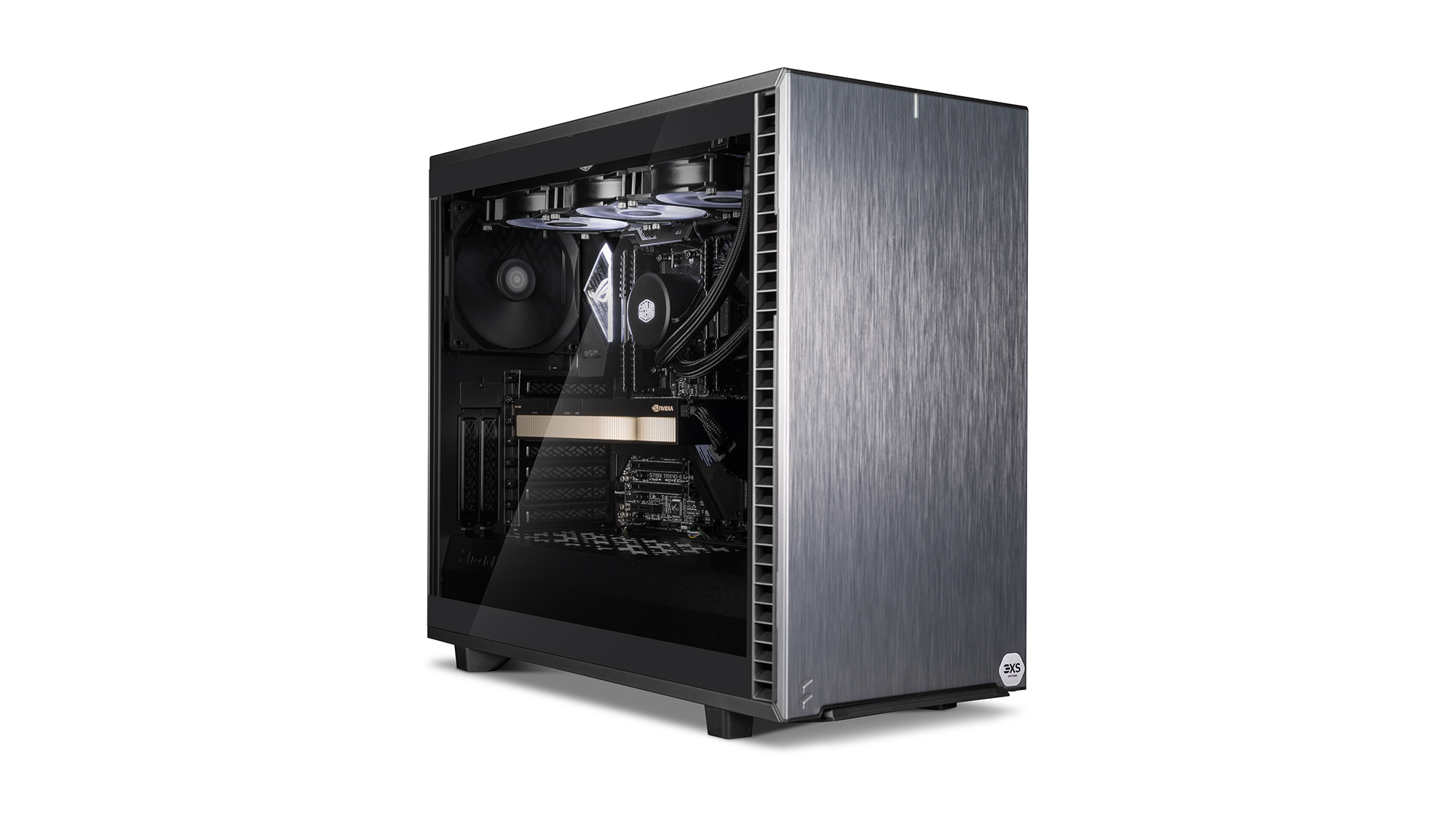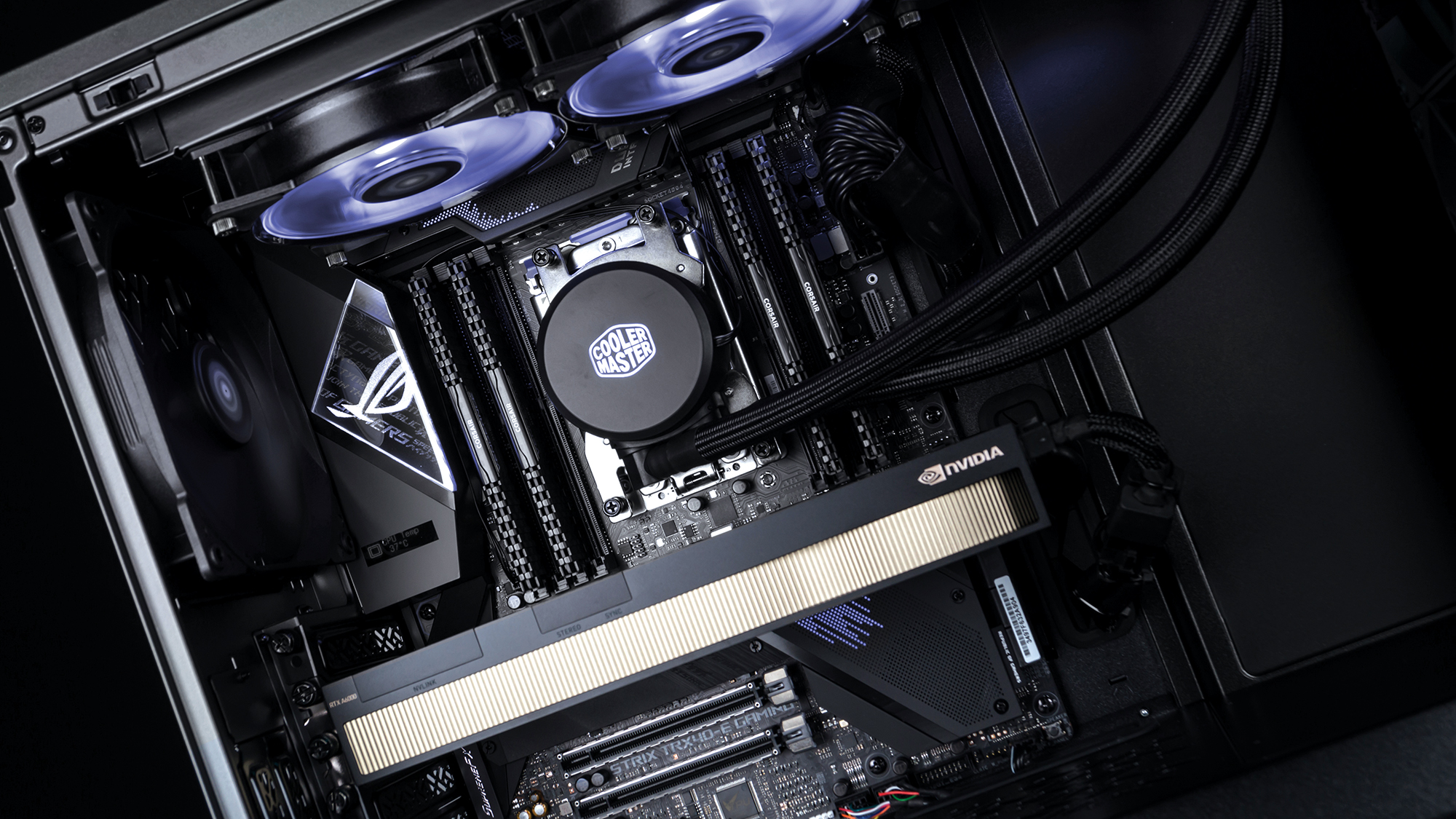Scan 3XS GWP-ME N1-32T review: The fastest content creation machine around
The perfect platform for Nvidia’s Quadro RTX A6000 flagship


-
+
Staggering performance
-
+
Plenty of room for expansion
-
+
Outstanding media and engineering potential
-
-
Expensive

Over the space of only three years, AMD has virtually taken over the performance high ground for workstation CPUs –but Nvidia still rules the roost for workstation 3D acceleration for content creation. So, to deliver the best of both worlds, Scan has sensibly outfitted this machine with AMD for the CPU and Nvidia for the GPU.
That Nvidia graphics card is monstrous: the latest flagship Quadro RTX A6000. 6000-series Quadros have always been uncompromising, but the A6000 takes things to another level, with 48GB of error-correcting GDDR6 memory. This is ideal for workloads where predictable precision is paramount, and bandwidth is a whopping 768GB/sec. The A6000 uses Nvidia’s Ampere architecture, boasting an unbelievable 10,752 CUDA cores. The previous Turing-based RTX 6000 only had 24GB of memory and 4,608 CUDA cores – less than half as many.
A GPU as powerful as the Quadro RTX A6000 – which makes up half the price of this system – warrants an equally powerful workstation platform, and Scan delivers. The AMD Ryzen Threadripper 3970X isn’t the top of the latest Threadripper range but it’s the most sensible choice for a balanced workstation. It still has 32 cores running at a base 3.7GHz with a boost up to 4.5GHz. With Performance Boost Overdrive, the number of cores that can achieve this at once depends on the power delivery and cooling ability of the workstation, making it a processor that’s equally great for single-threaded and multithreaded tasks.
Scan installs the Threadripper in an Asus ROG Strix TRX40-E Gaming motherboard, which has 2.5Gbits/sec LAN and three M.2 NVMe storage slots. Scan has partnered the CPU with a generous 128GB of Corsair Vengeance LPX 3,600MHz DDR4 memory, supplied as four DIMMs to take advantage of the Threadripper’s quad-channel memory architecture. Insert four more identical DIMMs into the vacant slots and you’ll hit the motherboard’s memory ceiling of 256GB.
While the AMD CPU and Asus board support PCIe 4, the Nvidia graphics card only operates at PCIe 3 speed. One peripheral device that does support PCIe 4, however, is the 2TB WD Black SN850 NVMe M.2 SSD supplied as the boot drive. And it’s fast, delivering stunning 7,068MB/sec sequential reads and 5,180MB/sec sequential writes in our tests.

Scan takes the typical approach of partnering this hugely quick main drive with a larger, slower SATA drive for general data. However, the days of conventional hard disks are clearly numbered because this device is a 4TB Samsung 860 Evo SSD. Even though the 570MB/sec sequential reading and 505MB/sec sequential writing speeds it delivers are more pedestrian than the SN850, that’s still more than twice as fast as conventional SATA hard disks.
All this potent hardware has been installed inside a sizeable Fractal Design Define 7 chassis – a serious black obelisk with few external features other than the USB and audio ports on the top front edge, although the version supplied has a glass side panel as well. This case provides bays for six 3.5in or 2.5in drives with potential for up to 14. There are two 2.5in bays, but a further two can be added. The processor is ably water-cooled by a CoolerMaster ML360R with its radiator at the top of the case, and there’s a 1,000W Corsair RMi Series modular 80+ Gold PSU to ensure all the components are reliably supplied with power.
When this machine gets going, you’re hit with a mighty roar, but in return, you get top-notch performance. The overall score in our benchmarks of 633 is excellent: the 3XS managed 226 in image editing, 594 in video encoding and 794 in multitasking. The Cinebench R20 rendering score of 17,526 is even more exceptional, with only AMD’s own 64-core Threadripper 3990X performing better.
The GPU is the star here, though, and running SPECviewperf 13 shows just how powerful the Quadro RTX A6000 is. For content creation, the 3XS managed 336 in the 3ds Max viewset and 417 in Maya. For engineering and CAD, 384 in Catia, 375 in Creo, 617 in Siemens NX and 196 in SolidWorks are all significantly ahead of anything we’ve tested before. And the GPGPU acceleration is out of this world, with 18,347 in LuxMark 3.1 where the previous Quadro RTX 6000 could only manage under 10,000.
In short, there’s little this Scan 3XS workstations won’t accomplish. Its modelling abilities are the best we’ve seen, and those 32 cores mean that multithreaded tasks will be dispatched without drama. The sole negative is its price. However, your £7,500 exc VAT buys a huge amount of workstation, and one that could soon pay you back in time savings for heavy content creation and engineering workloads.
Scan 3XS GWP-ME N1-32T specifications
| Processor | 3.7GHz AMD Ryzen Threadripper 3970X CPU |
| Motherboard | Asus ROG Strix TRX40-E Gaming |
| Expansion slots | 3x PCIe 4.0 x16 (x16/x16/x16), 1x PCIe 4.0 x4 |
| RAM | 128GB 3,600MHz DDR4 SDRAM |
| GPU | PNY Nvidia Quadro RTX A6000 graphics with 48GB GDDR6 ECC memory |
| Outputs | 4x DisplayPort 1.4a |
| SSD | 2TB WD Black SN850 M.2 NVMe SSD |
| Secondary drives | 4TB Samsung 860 Evo SATA SSD |
| Optical drives | N/A |
| Dimensions (WDH) | 240 x 547 x 475 mm |
| PSU make and model (power output) | Corsair RMi Series 80+ Gold (1,000W) |
| CPU cooler | CoolerMaster ML360R |
| Rear ports | 7x USB 3.2 Gen 2 Type-A+, 1x USB 3.2 Gen 2 Type-C, 4x USB 2.0, 1x Anti-surge 2.5G Ethernet port, 1x Ethernet, 1 x Optical S/PDIF out, 5 x Audio jacks |
| Front/top ports | 1x USB 3.1 Gen 2 Type-C, 2x USB 3.0, 2x USB 2.0 |
| Operating system | Windows 10 Pro 64-bit |
| Warranty (parts & labour unless stated) | 3yr warranty (1yr on-site, 2yr RTB, parts and labour) |
Get the ITPro daily newsletter
Sign up today and you will receive a free copy of our Future Focus 2025 report - the leading guidance on AI, cybersecurity and other IT challenges as per 700+ senior executives
Dr James Morris has worked as a technology journalist for over 25 years, including spending nine years on the staff of market-leading computer magazine PC Pro, the last five of which were as the publication’s editor. He specialises in enterprise-grade software and hardware, with a particular focus on content creation. He launched a pioneering video channel for HEXUS.net in 2006 and ran the video reviews channel for TrustedReviews.com for four years. He also runs a successful online digital content and commercial video production company, t-zero communications Ltd.
Dr Morris is a prolific technology writer and contributes commercial content for major IT brands including AMD, BlackBerry, Dell, Cognizant, HP, and IBM. He published a book on artificial intelligence, Can Computers Create Art? in 2009. He is also an academic, and is currently Pathway Director of the MA, Interactive Journalism at City, University of London.
Previously, he was course leader for the BA in Web Media Production at Ravensbourne University. He has a PhD in Philosophy, Art and Social Thought from the European Graduate School in Switzerland, a Master's in Media Arts from the New School in New York, USA, and a Bachelor's in Social Anthropology from the London School of Economics.
Dr. Morris can be found on Twitter at @Cyberwest, or emailed at j@tzero.co.uk
-
 ‘Phishing kits are a force multiplier': Cheap cyber crime kits can be bought on the dark web for less than $25 – and experts warn it’s lowering the barrier of entry for amateur hackers
‘Phishing kits are a force multiplier': Cheap cyber crime kits can be bought on the dark web for less than $25 – and experts warn it’s lowering the barrier of entry for amateur hackersNews Research from NordVPN shows phishing kits are now widely available on the dark web and via messaging apps like Telegram, and are often selling for less than $25.
By Emma Woollacott Published
-
 Redis unveils new tools for developers working on AI applications
Redis unveils new tools for developers working on AI applicationsNews Redis has announced new tools aimed at making it easier for AI developers to build applications and optimize large language model (LLM) outputs.
By Ross Kelly Published
-
 Google layoffs continue with "hundreds" cut from Chrome, Android, and Pixel teams
Google layoffs continue with "hundreds" cut from Chrome, Android, and Pixel teamsNews The tech giant's efficiency drive enters a third year with devices teams the latest target
By Bobby Hellard Published